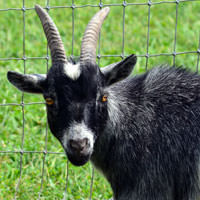
Although you might never have thought of raising some of these animals for meat, they might work perfectly for your farm.
 |
Goat
Goat meat, also called chevon or cabrito, is a favorite meat in most parts of the world, and it’s catching on in the U.S. as well. Cabrito kids are generally slaughtered and barbequed at a few weeks of age while freezer kids reach processing age at 4 to 5 months. Photo by Rachael Brugger
 |
Fish
If you have a pond, why not stock it with fish? Talk to your county extension agent or department of natural resources to see if your pond is suitable for fish farming (not all are). They can also tell you what species work best in your locale and where to buy fingerlings and commercially bagged fish food. Photo Courtesy iStockphoto/Thinkstcok
 |
Goose and Duck
Grow a goose or duck to serve at Christmas dinner next year. Geese mature quickly, with goslings reaching slaughter stage (roughly 8 pounds) at 12 to 14 weeks of age. Ducks are also fast maturing and easy to grow. Broiler-fryer ducklings weighing 3 to 6.5 pounds are ready to slaughter at 8 weeks of age and 4- to 7.5-pound roasters shortly after. You don’t need a pond to raise ducks or geese, and they’re fun and entertaining to have around. Photo by Rachael Brugger
 |
Emu
If you like dark meat and a lot of it, these are your birds. Emu meat is 98-percent fat free and the fat it contains is 43-percent monounsaturated, which helps lower bad LDL cholesterol in the human body. It’s also lower in cholesterol and higher in protein than chicken and is tender, juicy and delicious.
Photo courtesy Tom Brakefield/Stockbyte/Thinkstock
 |
Guinea Fowl
Guinea fowl meat is dark, lean, extra high in protein, low in fat, and a good source of vitamin B6, selenium and niacin. It has a luscious, slightly gamey flavor that makes it a favorite with European chefs. Photo Courtesy iStockphoto/Thinkstock
Game Birds
Other great choices include farmed pheasants, partridge and quail. They’re low maintenance and oh-so-tasty.




